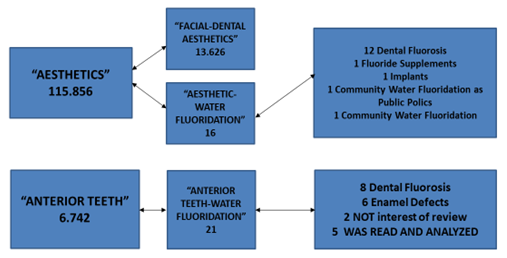MOJ
eISSN: 2379-6383


Short Communication Volume 11 Issue 2
1Health Surveillance Center of São Paulo State, São Paulo, Brazil
2Department of Politics of Public Health College of São Paulo University, Brazil
Correspondence: Mariângela Guanaes Bortolo da Cruz, Health Surveillance Center of São Paulo, State, São Paulo, Brazil, Department of Politics of Public Health College of São Paulo University, Brazil, Tel 55-011-9 9279 6898
Received: August 04, 2022 | Published: August 17, 2022
Citation: Cruz MGB, Narvai PC. Dental aesthetics and fluoridation: thematic typification of researches. MOJ Public Health. 2022;11(2):133-134. DOI: 10.15406/mojph.2022.11.00389
Water fluoridation is a public health tool that protects against dental caries, however its correlation with dental aesthetics is not known. Through an integrative review in the scientific publication Medline database, there were 115.856 articles when the term "Aesthetics" was searched. Specifying the searches, only 5 articles were found that related the impact of fluoridation on teeth. Despite the importance of analyzing possible contributions of water fluoridation to dental aesthetics, no specific article was found. The main hypothesis is the methodological difficulties to assess the correlation between water fluoridation and oral aesthetics.
Keywords: oral health, fluoridation, facial aesthetics and fluoridation, aesthetics and fluoridation
Fluoridated water adds a preventive benefit against dental caries, even in epidemiological scenarios with low prevalence of the disease.1 It is not known, however, which are the main axes of publication referring to fluoridation and aesthetics. This mini-review seeks to typify the thematic axes of publications related to the theme.
A search was carried out in the Medline bibliographic database, with the objective of producing an integrative review on the possible effect on dental or facial aesthetics of exposure to public water supply with optimal fluoride levels for the prevention of dental caries. Two search strategies and selection of articles available in the referred bibliographic database were used, using terms and expressions in English and Spanish. The first search strategy used the following filter sequence: aesthetic; dental - or facial aesthetic; dental aesthetic or facial aesthetic and water fluoridation. This strategy resulted in 18 articles. The second strategy used the filters: anterior teeth; anterior teeth and water fluoridation. The second strategy resulted in 21 works.
Of the total of 39 articles resulting from these 2 searches, all of them were read and those that according to titles and abstracts did not refer to the object of this review were excluded. After this process, only 5 related articles resulted, which were full read and analysed. The material was analyzed with reference to the possible impact of fluoridation of public water supply on the occurrence of dental caries, restorations and loss of permanent upper and lower anterior teeth.
With the first search strategy, 115.856 articles on aesthetics were split, reduced to 13.626 by the “dental aesthetic” or “facial aesthetic” filters. This product was submitted to the “water fluoridation” filter and no articles remained. The filter “water fluoridation” for the term “aesthetic” resulted in 16 articles, of which 12 referred to dental fluorosis, 1 about “fluoride supplements”, 1 about “implants”, 1 about “community water fluoridation as a public policy” and 1 had a systematic review on “community water fluoridation”.
With the second search strategy, we started with 6,742 articles on “anterior teeth” which, when submitted to the “water fluoridation” filter, resulted in 21 articles. Of these, 8 referred to dental fluorosis, 6 to enamel defects and 2 were discarded as they did not refer to the object of interest of the present review. The remaining 5 articles were read and analyzed (Figure 1).

Figure 1 Schematic drawing of search results in Medline database, number of articles by theme, July 2022.
From the reading of the five articles, 4 were discarded because they referred to the theme that departed from the object of the present review. Only one article (Caries progression in 12-to 16-year-old schoolchildren in fluoridated and fluoride-deficient areas in Brazil) was left for the proposed integrative review. The authors considered that “water fluoridation may reduce the rate of caries initiation, but relatively little is known of its effect on rates of caries progression through the enamel and the dentin” and, in a “longitudinal study designed to compare rates of caries progression in fluoridated and fluoride-deficient areas” they assessed the progression of “Approximal caries progression was evaluated on two standardized sets of bitewing radiographs taken at a 12-month interval of 290 22- to 16-year-old Brazilian schoolchildren.2 Pitts' scoring system was used to measure caries progression on conventional bitewing images. Caries progression data on the occlusal, free-smooth, and approximal surfaces of the anterior teeth were collected via clinical visual examinations”.
The results indicated that “the mean rate of approximal caries progression in schoolchildren living in fluoridated areas (0.54) was found to be 62% lower than that in children from fluoride-deficient areas (1.41). When progression rates were adjusted for the initial number of decayed surfaces per subject, differences were statistically significant for lesions located at the inner half of the enamel at baseline (11% in the fluoridated areas vs. 16.5% in the fluoride-deficient areas). Multivariate logistic regression analysis revealed that residence in a fluoride-deficient area a significant risk factor for caries after progression controlling for caries prevalence (D1FS), number of cavitated carious lesions, whether tooth type was molar or premolar, and tooth brushing frequency.” In view of these results, they concluded that “these results suggest that water fluoridation reduces the rates of caries progression through the enamel and dentin, but the effect was more pronounced for lesions in the inner enamel than for those in the dentin”.3,4
Despite the importance of verifying possible contributions of the water fluoridation process to dental aesthetics, no specific related articles were found. The main hypothesis is the methodological difficulties to assess the correlation between water fluoridation and oral aesthetics.
None.
The authors declare that there is no conflict of interest.

©2022 Cruz, et al. This is an open access article distributed under the terms of the, which permits unrestricted use, distribution, and build upon your work non-commercially.